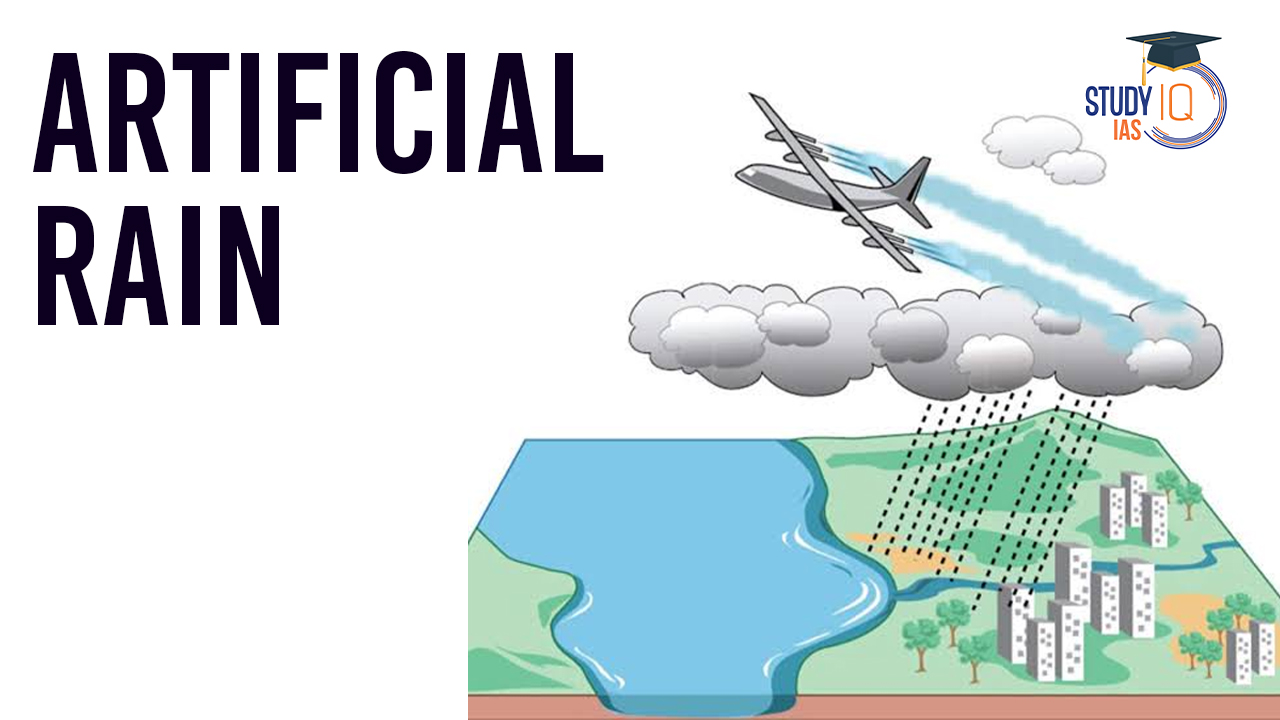Table of Contents
Artificial rain, or cloud seeding, is a weather modification method that induces precipitation by introducing substances into clouds. Common agents like silver iodide or solid carbon dioxide (dry ice) are utilized. Silver iodide particles function as artificial condensation nuclei, promoting the formation of water droplets. Deployment methods include large cannons shooting particles into the sky or aeroplanes dispersing them from above. This innovative technique aims to enhance rainfall and is crucial in various applications, from agricultural practices to addressing water resource management challenges.
We’re now on WhatsApp. Click to Join
Artificial Rain in Delhi
The Delhi government is planning to use artificial rain to reduce air pollution in the city. The government is planning to use cloud seeding technology, which involves adding silver iodide particles to clouds to act as condensation nuclei. The particles can be added using large cannons or aeroplanes.
The Delhi government’s two-phase pilot study on artificial rain will cost around ₹13 crore. The government aims to implement the first artificial rain in the city by November 20.
What is Artificial Rain?
Artificial rain, also known as cloud seeding, is a weather modification technique designed to induce or increase precipitation. This process involves introducing certain substances, often referred to as cloud seeding agents, into clouds to encourage the formation of precipitation in the form of rain or snow.
Common cloud seeding agents include silver iodide and solid carbon dioxide (dry ice). These substances serve as nuclei around which water droplets can form, facilitating the process of condensation and ultimately leading to the development of precipitation. Artificial rain is often employed for various purposes, including enhancing rainfall in specific areas or mitigating drought conditions.
Artificial Rain and Cloud Seeding
Cloud Seeding, a form of artificial rain, involves introducing substances like silver iodide into clouds to stimulate precipitation. This process aims to enhance water resources, benefit agriculture, and prevent wildfires. While it offers potential solutions to drought and water scarcity, concerns include environmental impacts, ethical considerations, and the unpredictability of results.
The legal status of weather modification is also unclear. Despite these challenges, ongoing research is vital to assess the effectiveness and long-term consequences of cloud seeding, striking a balance between addressing water-related issues and minimizing potential risks.
Artificial Rain Process
The artificial rain process, also known as cloud seeding, involves several key steps to induce or enhance precipitation. Here’s an overview of the typical procedures:
- Cloud Identification: Meteorologists pinpoint clouds with potential for precipitation but require assistance.
- Seeding Agent Selection: Common agents like silver iodide or dry ice are chosen to act as nuclei for water droplet formation.
- Agent Dispersion Methods: Agents are dispersed via Aircraft: Flares release seeding agents from overhead, Ground-Based Generators: Cannons or generators release agents into the atmosphere.
- Nucleation and Cloud Enhancement: Seeding agents serve as nuclei, promoting the formation of ice crystals or water droplets within clouds.
- Precipitation Initiation: A sufficient number of droplets or crystals lead to precipitation (rain, snow) depending on atmospheric conditions.
- Monitoring Weather Conditions: Ongoing observation by meteorologists to evaluate the success of cloud seeding.
- Evaluation of Effectiveness: Assessment of precipitation patterns to determine the overall impact of the artificial rain process.
- Meteorological Factors: Success depends on factors like cloud type, temperature, and humidity.
- Multi-Purpose Applications: Cloud seeding is utilized for increasing water resources, mitigating drought, and managing weather patterns for agriculture and environmental needs.
Artificial Rain Advantages and Disadvantages
Artificial rain, also known as cloud seeding, is a weather modification technique designed to induce precipitation by introducing various substances into clouds that serve as cloud condensation or ice nuclei. While it has been used in some regions to address water scarcity or enhance precipitation, there are both advantages and disadvantages associated with artificial rain.
Advantages of Artificial Rain
Increased Precipitation:
- The primary goal of artificial rain is to increase precipitation, which can be crucial in areas facing water shortages or drought conditions.
Agricultural Benefits:
- Adequate rainfall is essential for agriculture. Artificial rain can potentially enhance crop yields and support overall agricultural productivity.
Water Resource Management:
- Artificial rain can contribute to the management of water resources by increasing the availability of water in reservoirs, rivers, and groundwater.
Wildfire Prevention:
- In regions prone to wildfires, artificial rain can be used to dampen dry conditions and reduce the risk of fires spreading.
Hydroelectric Power Generation:
- Increased precipitation can positively impact water levels in reservoirs, benefiting hydroelectric power generation.
Disadvantages of Artificial Rain
Environmental Impact:
- The substances used in cloud seeding, such as silver iodide or potassium iodide, may have environmental impacts. While studies suggest they are generally low-risk, there are concerns about their long-term effects on ecosystems.
Lack of Control:
- Weather systems are complex and dynamic. The effectiveness of cloud seeding is not always guaranteed, and there may be limited control over where and when the precipitation occurs.
Ethical Concerns:
- There are ethical concerns related to manipulating weather patterns. Critics argue that altering natural precipitation may have unforeseen consequences and disrupt ecosystems.
Legal Issues:
- The international legal status of weather modification is not well-established, and there may be disputes over the use of artificial rain, especially if it affects neighbouring regions.
Cost:
- Implementing and maintaining cloud seeding programs can be expensive. The cost-effectiveness of these programs is a consideration, especially in comparison to other water management strategies.
Unintended Consequences:
- Manipulating weather patterns may have unintended consequences on local and regional climates. Changes in precipitation patterns could impact natural ecosystems and biodiversity.
Public Perception:
- Some people may be sceptical or concerned about the use of artificial rain, leading to public opposition or resistance to its implementation.
Artificial Rain UPSC
Artificial rain, achieved through cloud seeding, employs substances like silver iodide to stimulate precipitation, addressing water scarcity and aiding agriculture. The Delhi government plans to combat air pollution using this technology, anticipating results by November 20. Cloud seeding involves identifying suitable clouds, selecting seeding agents, and dispersing them via aircraft or ground-based generators.
While cloud seeding offers advantages such as increased precipitation and wildfire prevention, concerns persist, including environmental impact, ethical considerations, and unpredictable outcomes. Ongoing research is crucial to assess efficacy and strike a balance between addressing water-related challenges and minimizing potential risks associated with this weather modification technique.


 Biomass Satellite, Key Objectives and Pa...
Biomass Satellite, Key Objectives and Pa...
 Laser Weapon System, Advantages and Asso...
Laser Weapon System, Advantages and Asso...
 Vitamin D Deficiency: Causes, Symptoms a...
Vitamin D Deficiency: Causes, Symptoms a...





















